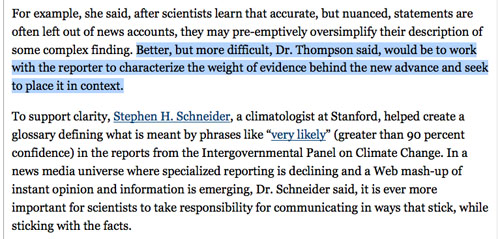- Genre: Contextual Analysis
- Audience: educated, curious readers, some of whom might be skeptical
- Learning Outcomes: Rhetorical Knowledge; Critical Thinking, Reading, and Writing; Knowledge of Conventions; Processes
- Length: 1500-1750 words
- Sources: minimum of eight credible sources, at least four of which come from peer-reviewed scholarly publications; one of which must be a book
- Background: St. Martin’s e-Handbook: choosing topics (12); conducting research (13); integrating sources (15)
By this point in the term, and after an individual conference with me, you should have identified an issue or a question that interests you for further inquiry from reading the New York Times: a trend, an idea, an argument or advocacy position, or an ongoing news story.
Your challenges for this project are to first spend some time in inquiry mode, asking questions — to whom does this issue matter? Why? What is interesting about it? What is important about it? What is at stake? — to contextualize your issue and to then, finally, to take a persuasive position on it.
Possible examples:
 Consider how the NYT has covered and continues to cover Tupac Shakur.
Consider how the NYT has covered and continues to cover Tupac Shakur.
“Thugs is convicts in God’s prison”: put Shakur’s lyric, “Thug Love” into context with the NYT’s representations of him: what’s at stake in these lyrics? Do they have arguments? Are the lyrics composed for political or aesthetic (or some other) ends? What do people who research and write about Shakur seem to value? How can you tell?
 Last quarter, a student chose to do a textual analysis of the “Fashion & Style” section of the NYT, drawing on several weeks of the newspaper’s textual and visual materials — fashion and style are highly rhetorical activities, she noted — and a contextual analysis project of a section of newspaper could reveal even richer meanings, because it could draw on a wider range of sources. What does the NYT seem to value? How can you tell? What kind of reality does the NYT represent?
Last quarter, a student chose to do a textual analysis of the “Fashion & Style” section of the NYT, drawing on several weeks of the newspaper’s textual and visual materials — fashion and style are highly rhetorical activities, she noted — and a contextual analysis project of a section of newspaper could reveal even richer meanings, because it could draw on a wider range of sources. What does the NYT seem to value? How can you tell? What kind of reality does the NYT represent?
 Research the NYT’s archives, using disciplinary key terms from your career, creative, professional, or community aspirations: how does the NYT cover and represent Nicaragua? Or the field of Accounting? Or boxing? Can your contextual analysis reveal, report on, or advocate for a particular position? Yes, it can.
Research the NYT’s archives, using disciplinary key terms from your career, creative, professional, or community aspirations: how does the NYT cover and represent Nicaragua? Or the field of Accounting? Or boxing? Can your contextual analysis reveal, report on, or advocate for a particular position? Yes, it can.
 There is a statue outside of the Student Union — “A Twentieth Century Priest” — of Msgr. John Egan, inscribed with the quote, “What are you doing for justice?” I assume that this is a rhetorical question. But the questions it raises! What is the difference between fairness and justice? Should college students in general, and DePaul students in particular, be active in social-justice issues? Why or why not? How has the NYT covered and represented student activism, social justice, and community organizing? What can this tell us about what people value?
There is a statue outside of the Student Union — “A Twentieth Century Priest” — of Msgr. John Egan, inscribed with the quote, “What are you doing for justice?” I assume that this is a rhetorical question. But the questions it raises! What is the difference between fairness and justice? Should college students in general, and DePaul students in particular, be active in social-justice issues? Why or why not? How has the NYT covered and represented student activism, social justice, and community organizing? What can this tell us about what people value?
More possibilities after brainstorming in class:
- What is the relationship between art and fashion?
- Is love an emotion or a chemical reaction?
- What is the US’s relationship with Egypt? What should it be?
- What is the history of Pilsen and how is it usually reflected in histories of Chicago?
- Should colleges drop competitive sports?
- What is the purpose of college?
- Is there a “rhetoric of terrorism?”
- What can a contextual analysis tell us about Aaron Swartz and his work?
These examples are meant to show the possible scope of a contextual analysis project; I will negotiate yours with you, and will encourage you to invest this time on an issue that you genuinely care about, and for which you want to make compelling, successful arguments. Also note that these representative examples are based on inquiry — not initially on a thesis or based on argument — and that is where we will start: with questions.
Our Process:
- Sunday, 4/21: Online library workshop
- Monday, 4/29: Preliminary Inquiry Question
- Wednesday, 5/1: Project Proposal & Map
- Monday, 5/6: Project First Draft
- Monday, 5/13: Project Second Draft (workshop & peer review)
- Monday, 5/20: Project Final Draft
Good examples of contextual-analysis essays
* Who’s Afraid of Post-Blackness? What It Means to Be Black Now — note how the writer weaves sources and examples throughout: quoting, delivering statistics, wrestling with contradictions, integrating a range of voices, all in the service of a single line of inquiry.
* “Do Birds Have Emotions?”
“Emotions, feelings, awareness, sentience, and consciousness are all difficult concepts. They are tricky to define in ourselves, so is it any wonder they are difficult in birds and other nonhuman animals? Consciousness is one of the big remaining questions in science, making it both an exciting and a highly contentious area of research.”
You can see the writer’s contextual-analysis map: “Biologists, psychologists, and philosophers have argued over these issues for years, so I cannot hope to resolve them. Instead, I have adopted Darwin’s approach—thinking about what might be going on in a bird’s head and imagining a continuum, with displeasure and pain at one end and pleasure and rewards at the other.
- Sample: The Contextual Effects of Race on White Voter Behavior: The 1989 New York City Mayoral Election
- Sample: “No day shall erase you from the memory of time” (Op-Ed) and Letter
- Sample: Evaluating the Framing of Islam and Muslims Pre- and Post-9/11: A Contextual Analysis of Articles Published by the New York Times
- Sample: Who Survives on Death Row?: An Individual and Contextual Analysis (PDF)



